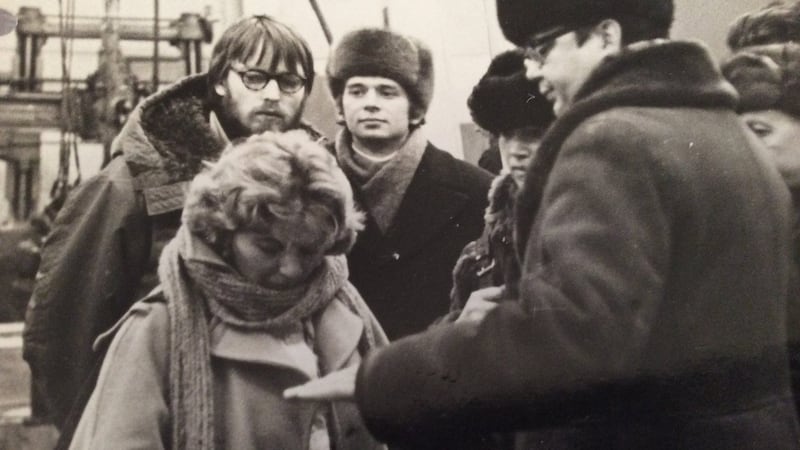Reading Russian in Trinity College could never be the same as hearing it spoken by ordinary Russians as they grunted their way to their kitchenettes to munch breakfast and discuss the affairs of the day over a glass of kefir.
So in 1977 I was really delighted to be awarded a scholarship to study the Russian language and its literature at the great Lomonosov University in Moscow. It was there that I met Tania Michaelova, who expressed a keen interest in studying Modern Irish, and so we met two or three times a week to speak Irish together. Tania was very gifted, and it wasn't long before she became fluent in Irish. So fluent, that she even fooled Pádraig Ó Snodaigh into thinking she was visiting from Ireland when he came with a delegation to Moscow in the early 1980s to celebrate St Patrick's Day with the Irish-Russian Friendship Society.
Old Irish was, at that time, already being studied in both Moscow and Leningrad, but Modern Irish was still unavailable to third-level Russian students. Both Tania and I worked away over the next six years and, by gathering together a number of other enthusiastic, like-minded people, we eventually stimulated enough interest to cause the University to open a small, one-lecturer department.

The interest in Irish grew over the years and today there is a long list of publications and translations produced by gifted graduates from Lomonosov University. Amongst these are very brilliantly crafted translations of An Táin, An Béal Bocht and, of course, more modern authors, including many of Alan Titley's works, such as his hilarious and much-loved play Tagann Godot. Professor Michaelova has herself over the years produced a huge number of translations and even written a very effective primer for those Russians who study Modern Irish in Moscow today.
Dr Victor Bayda is presently running the department and speaks Irish with almost native fluency, having spent time in the Connemara Gaeltacht. Since 2010, Modern Irish has become a full five-year degree course at the University, which clearly shows the keen interest Russian people have in the Irish language and its culture.
It is no problem today, of course, for any Irish speaker anywhere in the world to Skype a friend in Connemara or Gaoth Dobhair at the touch of a button. The red-hot rapid flow of information that is so ubiquitously available today could never have been imagined in the deep-freeze of the Cold-War years, before Perestroika and the fall of the Berlin Wall.
All languages are in essence a symbiotic relationship similar to a fish and the water it lives in. The water gives the fish its freedom but the fish also has to maintain certain characteristics in order to live in that water. Learning a new language is like a fish that has been transformed into a bird. The bird is still living in the same universe of planets and stars, but oh how different it all is! As it flies freely through the air it can feel the wind in its feathers, see beautiful sunsets and enjoy a totally different life experience to the fish it once was in the water-world below.
On this occasion of Seachtain na Gaeilge, speaking whatever Irish we can muster encourages an awakening in all of us of centuries of our own particular brand of living together: a brand that informs our innately Irish take on the world.
Without the Irish language, my travels to Russia would have been a very one-way enterprise indeed, because I would have entered their country le mo dhá láimh chomh fada lena chéile - bereft of anything to share. But as it happened, I arrived with a great treasure, a whole new world to share with my new Russian friends. Being able to share the Irish language with the people I was meeting while I was there, some forty years ago, was not only an extraordinary privilege for me, but was also as enriching for them as learning Russian and reading the great Russian authors has been and still is for me today.
Kiss My…! (Póg mo Thóin)
It is never The Irish-Language Thesaurus, which took some 15 years to complete, or The Islander translation, over which both David Sowby and I slaved for at least ten years. It is always the Dictionary of English-Irish Slang that grabs the attention of both critics and admirers alike. When Kiss My... first appeared there were indeed many who were shocked and appalled by its publication. Even this year there has been much heated debate over the contents of the second edition which has just been published. How is it possible to print such 'vile' and 'offensive' words? Well, actually, words are neither vile nor offensive. They can certainly be used in that way if that is the intent of the person using them. But then again, any words at all can be used offensively and in a vile manner, even the most seemingly neutral ones.
Words are like people - sometimes they experience tremendous popularity and are OK to be seen with, but later they may lose their popularity and become ‘distasteful’ or even ‘pariahs’. There are many words that were considered normal vocabulary in the mid-20th century but today are considered to be completely unacceptable by most English speakers. Slang is the rawest of language, however. It’s the language nearest the soul and the closest to our wildest passions. For me it is also the purest and most authentic mirror of who we are. If you want to understand another language, you certainly need to understand the way that language is spoken on the streets or when the children aren’t in the room.
Kiss My…! Dictionary of English Irish Slang is published by New Island newisland.ie












